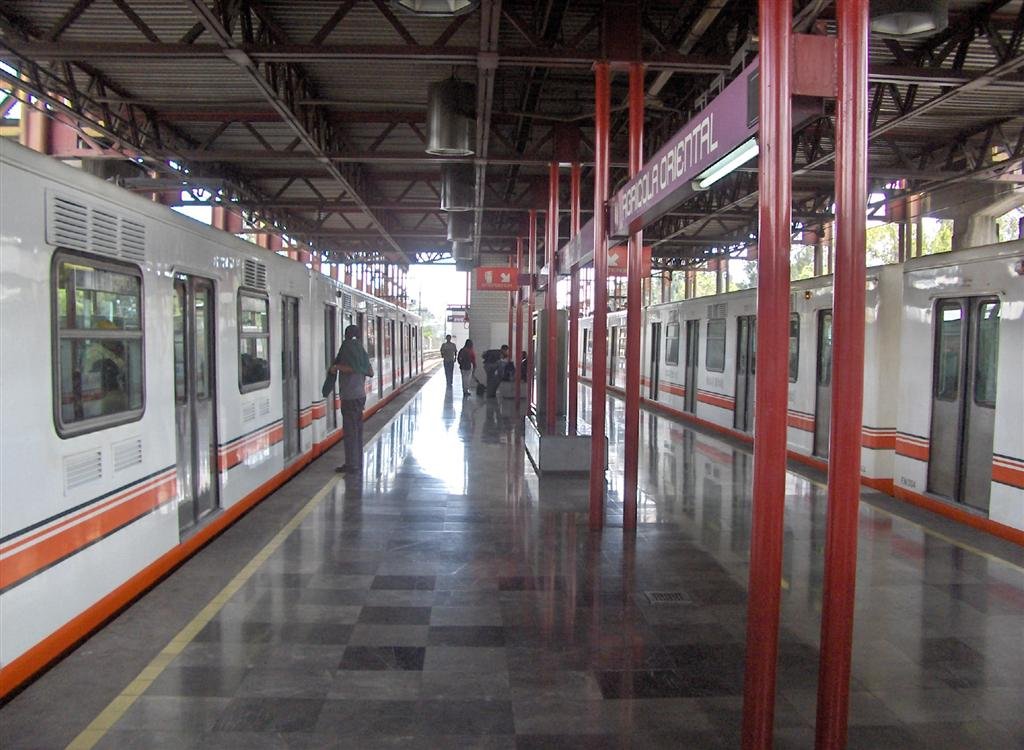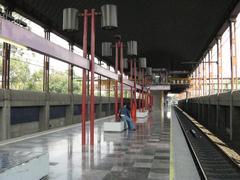
Agrícola Oriental Mexico City: Visiting Hours, Tickets, and Historical Sites Guide
Date: 15/06/2025
Introduction
Agrícola Oriental, located in the eastern sector of Mexico City within the boroughs of Iztacalco and Venustiano Carranza, is a neighborhood that traces its roots from lacustrine agriculture to a vibrant urban community. Once farmland on the bed of Lake Texcoco, it has transformed into a densely populated area with dynamic markets, community parks, and cultural centers. This guide explores Agrícola Oriental’s history, urban development, visiting hours, ticketing, transportation, safety tips, and nearby attractions—offering a comprehensive resource for travelers seeking an authentic Mexico City experience (MexicoCity.cdmx.gob.mx).
Contents
- History and Early Agricultural Roots
- Urban Development (1930s–1950s)
- Demographic Growth and Urban Expansion
- Infrastructure and Transportation
- Practical Visitor Information
- Cultural and Recreational Landmarks
- Faro Cultural y Recreativo Iztacalco
- Local Markets (Mercado Agrícola Oriental, Mercado Leandro Valle)
- Community Spaces and Art Events
- Authentic Local Experiences
- Transportation and Safety Tips
- Nearby Attractions and Day Trips
- Accessibility and Seasonal Events
- Visitor Etiquette
- Frequently Asked Questions (FAQ)
- Conclusion and Key Takeaways
- Sources
History and Early Agricultural Roots
Agrícola Oriental, meaning “Eastern Agricultural,” began as fertile farmland on the former Lake Texcoco. This area was part of the Valley of Mexico’s extensive lacustrine system, supporting chinampas (artificial islands for agriculture) and canal networks, which enabled crop cultivation throughout the colonial period. The wheat sheaf logo at Metro Agrícola Oriental commemorates this agrarian legacy (MexicoCity.cdmx.gob.mx).
Urban Development (1930s–1950s)
Urbanization of Agrícola Oriental accelerated in the 1930s as Mexico City expanded. Former farmlands were subdivided, and by the 1950s, the neighborhood and nearby areas like Agrícola Pantitlán featured grid-patterned streets, replacing canals and wetlands. This development mirrored broader trends as the city extended into its periphery (National Geographic Blog).
Demographic Growth and Urban Expansion
By the late 20th century, Agrícola Oriental became a densely populated residential zone. While central Mexico City’s population declined post-1970s, peripheral neighborhoods like Agrícola Oriental experienced significant growth due to new housing developments. Between 1990 and 2014, the metropolitan area’s land coverage grew by 128%, outpacing population growth and reflecting the city’s sprawling nature (New Geography).
Infrastructure and Transportation
A pivotal moment came in the 1990s with the introduction of Metro Line A, integrating Agrícola Oriental into the city’s extensive transport network. The Agrícola Oriental Metro station, while the least used on the line with about 10,000 daily riders, symbolizes the area’s agricultural roots with its wheat sheaf logo. Connectivity is further boosted by proximity to major transit hubs like Pantitlán (MexicoCity.cdmx.gob.mx).
Practical Visitor Information
Getting There:
Agrícola Oriental is accessible via Metro Line A (Agrícola Oriental station) and Metro Line 9 (nearby Canal de San Juan). Multiple bus routes also serve the area.
Metro Hours:
Approximately 5:00 AM to midnight daily; standard Metro fare applies (no extra ticket required).
Walking and Local Mobility:
The neighborhood is walkable, with main attractions within 1–2 km of Metro stations. Sidewalks can be uneven; exercise caution.
Driving:
Not recommended due to congestion and limited parking.
Accessibility:
Public spaces like the Faro Cultural are wheelchair accessible, though markets may be crowded and less accessible.
Cultural and Recreational Landmarks
Faro Cultural y Recreativo Iztacalco
A 15,000 m² arts and community center, the Faro Cultural is a hub for creativity, education, and wellness. Facilities include an interactive library, outdoor gym, jogging track, sports courts, skating rink, and an open-air forum. The center offers year-round workshops, performances, and community events.
- Hours: Tuesday–Sunday, 9:00 AM–7:00 PM (confirm hours on official site)
- Tickets: Free entry; some workshops may require a small fee
- Accessibility: Wheelchair accessible
Mercado Agrícola Oriental
Known as the largest market in Iztacalco, Mercado Agrícola Oriental offers fresh produce, traditional foods, and artisan goods.
- Hours: Daily, 6:00 AM–7:00 PM (MexicoCity.cdmx.gob.mx)
- Tickets: Free entry
- Accessibility: Partially accessible; some stalls may be crowded
Mercado Leandro Valle
This market, opened in 1969, is renowned for its wide variety of local produce, meats, and fondas serving traditional Mexican meals at affordable prices.
- Hours: Daily, 6:00 AM–6:00 PM
- Tickets: Free entry
Community Spaces and Art Events
Agrícola Oriental boasts green zones like Parque Leah Katiuska Uribe Sánchez and Parque Acteal, which serve as social hubs. The Faro regularly offers workshops in arts, music, and dance and presents concerts, theater, and cultural festivals, especially during major holidays.
Authentic Local Experiences
Agrícola Oriental is not a tourist-centric area, making it ideal for immersing yourself in daily Mexican urban life. Enjoy meals at fondas, shop at bustling markets, participate in workshops, and interact with friendly residents.
Transportation and Safety Tips
- Use the Metro or authorized taxis/rideshare apps like Uber and Didi (The Broke Backpacker).
- Avoid driving due to traffic and limited parking.
- Keep valuables secure in crowded spaces, especially in markets and on public transport.
- Daytime visits are safest; avoid poorly lit areas at night.
- Basic Spanish is helpful; English is not widely spoken locally.
Nearby Attractions and Day Trips
- Cerro de la Estrella: Hiking, archaeological sites, and panoramic views (CDMX Secreta).
- Centro Histórico: Iconic landmarks and museums, easily reached by public transport.
- Other Markets: Mercado Jamaica for flowers, Mercado de la Merced for food, and Mercado de Sonora for folk magic (Culturestraveled.com).
Accessibility and Seasonal Events
Most public spaces have basic accessibility features. Seasonal community festivals occur throughout the year, with highlights during Día de los Muertos and Independence Day. June weather is pleasant but expect occasional rain (Let’s Travel to Mexico).
Visitor Etiquette
- Respect local customs and community spaces.
- Ask before photographing people, especially vendors.
- Support local businesses by shopping and eating in markets.
- Participate in workshops or public events for a deeper cultural experience.
Frequently Asked Questions (FAQ)
Q: What are the visiting hours for Faro Cultural y Recreativo Iztacalco?
A: Tuesday to Sunday, 9:00 AM–7:00 PM (confirm on the official website).
Q: Do I need a ticket to visit the markets or Faro Cultural?
A: Entry is free; some workshops or events may have a small fee.
Q: Is Agrícola Oriental safe for tourists?
A: Yes, with standard urban precautions. Daytime visits are recommended.
Q: How do I get there from downtown Mexico City?
A: Take Metro Line A to Agrícola Oriental station; local buses and taxis are also available.
Q: Are guided tours available?
A: Not regularly, but workshops and events at the Faro sometimes include guided elements.
Conclusion and Key Takeaways
Agrícola Oriental exemplifies Mexico City’s evolution from agricultural land to urban neighborhood. Visitors can enjoy vibrant markets, the unique Faro Cultural y Recreativo Iztacalco, and authentic local experiences. Accessibility via Metro and practical safety tips make it ideal for travelers seeking to explore beyond the city’s tourist core. Respect local culture, support small businesses, and immerse yourself in the neighborhood’s dynamic community spirit.
For further tips, event updates, and interactive maps, download the Audiala app and follow our social media channels. Explore our guides on Mexico City neighborhoods and local markets to maximize your experience.
Sources
- Exploring Agrícola Oriental: History, Urban Development, and Cultural Significance in Mexico City, 2025, Mexico City Government (MexicoCity.cdmx.gob.mx)
- Visiting Agrícola Oriental: Cultural Highlights, Visitor Information, and Local Tips, 2025, Mexico City Government (MexicoCity.cdmx.gob.mx)
- Visiting Agrícola Oriental: Cultural Landmarks, Markets, and Local Experiences in Mexico City, 2025, Mexico City Government (MexicoEscultura.com)
- Visiting Agrícola Oriental: Transportation, Safety, and Travel Tips for Mexico City’s Vibrant Neighborhood, 2025, Wikipedia and The Broke Backpacker (Wikipedia) (The Broke Backpacker)
- Urban Growth and Metropolitan Expansion in Mexico City, 2015, National Geographic Blog (National Geographic Blog)
- Expanding Productive Mexico City: The Evolving Urban Form, 2015, New Geography (New Geography)











































































































































































